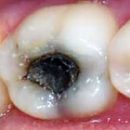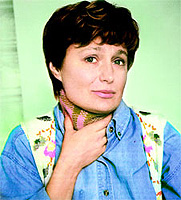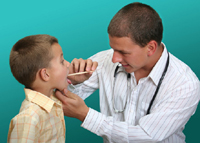What is chronic rhinitis? What is catarrhal rhinitis? What is allergic and vasomotor rhinitis? Answers to these questions you will find in the article.
Content
Chronic rhinitis
Chronic rhinitis is a fairly large group of diseases characterized by common symptoms: basic - the difficulty of nasal breathing, discharge from the nose, the decrease in the smell. The following symptoms are also bothering the following symptoms - itching and burning in the nose, sneezing, headache, fatigue and drowsiness, dryness in the nose, the formation of crusts, feeling of the unpleasant odor, minor nasal bleeding, accumulation of thick mucus in the nasopharynk, irritation of the skin of the nose and top lips, snoring and worsening sleep quality. There are many classifications of chronic rhinitis.
I will give the most appropriate (in my opinion):
- Catarial
- Allergic
- Seasonal
- Year-round
- Vasomotor
- Atrophic (including ozen)
- Hypertrophic
- Drug
- Specific
- Other forms of rhinitis
Before disassembled each form, it should be said that similar symptoms can also cause other diseases of the nose and nasopharynx (deformation of the nasal partition, chronic sinusitis, nasal polyposes, neoplasms, adenoids and some other diseases).
Catarial rhinitis
Catarial rhinitis - a disease characterized by constant catarrhal (not purulent) inflammation of the mucous membrane of the nasal cavity. The factors of the development of this disease include a high bacterial dissemination of the mucous membrane, frequent respiratory viral infections (some scientists believe that after recovery, some of the viruses do not die, but continues to exist in the cells of the mucous membrane, causing weakly generated symptoms of the disease), a decrease in the immune system, high pollution inhaled air with various types of dust and combustion products. Symptoms of the disease - the difficulty of nasal respiration, discharge from the nose, the decrease in the smell is usually expressed moderately. Treatment consists of destinations of local antibacterial agents, mucolithics, nasal soul, binding drugs, anti-inflammatory reception, physiothery. Subsequently, immunization inhalation vaccines is often used.
Allergic rhinitis
Allergic rhinitis - a disease associated with allergen hit (substance causing an allergic reaction) to the mucous membrane of the nasal cavity.
Allergic rhinitis can appear seasonally (which is associated with the flowering of certain plant species) or year-round. Allergic rhinitis is often combined with bronchial asthma, allergic conjunctivitis, urticule and other allergic diseases. Often the consequence of allergic rhinitis becomes the development of polypotic rhinosinusitis (polyps) and hypertrophy of the lower nose shells. Symptoms of allergic rhinitis (besides major) are: itching and ticking in the nose, redness of the nose skin, abundant transparent watery discharge, tear, sneezing. Currently, antihistamines and nasal corticosteroids are prescribed to the treatment of allergic rhinitis. It is also recommended that the sensitivity to allergens is also recommended because vaccination is possible to the detected allergen, which may continue to protect against allergic reactions to this allergen.
Vasomotor rhinitis

Vasomotor rhinitis is a functional state associated with a violation of the regulation of the tone of blood vessels under the mucous membrane of the lower nose shells. Normally, the lower nasal sinks regulate the volume of inhaled air, decreasing or increasing in size (due to blood flow) reacting to its temperature and humidity, as well as the tone of the vessels in one of the lower nose shells more than in another (the tone changes approximately 1 time per hour) - T.N. «Nasal cycle». With vasomotor ritin nasal cycle or shortening or lengthened or in general on both sides, the tone of the vessels is low. The characteristic signs of vasomotor rhinitis is the alternate concreterance of one of the half of the nose or the appearance of concurrencies at the reception of a lying position on the side that a person lies.
Vasomotor rhinitis is often developing in people with neuro-circulatory dystonia, in hypotonists, in patients with astheno-vegetative syndrome, with some endocrine diseases, more often in young or prelimobile age. Treatment of vasomotor rhinitis - the problem is quite complicated, there are many ways depending on the main pathology. Hardening and physiotherapure do not give high results. Currently, various types of intraphonic injections and surgical treatment methods are most often used. Injector injections include intracraquinical blockades (as a rule, with novocaina), the introduction of sclerosing drugs and the administration of long-acting glucocorticosteroids, these treatment methods also do not have high efficiency and can be recommended as initial treatment. Surgical treatment methods are also quite varied. We list them from the oldest to the most new: submucous vasotomy, Galvanokauska, ultrasound disintegration, intrachnic radio electrosagulation, laser photodegradation. All listed methods have approximately the same efficacy and its pros and cons, Galvanokauski is currently practically not used, as it is recognized «Calee» Operation. The meaning of all of the above operations is reduced to destroy the submissible vessels of the lower nose shells and do not allow the sinks to increase.
Atrophic rhinitis
Atrophic rhinitis is characterized by the formation of a large amount of dry crust, a dryness sensation, easy injuries of the nasal mucosa, may be a change in smell (the appearance of an unpleasant smell that surrounding people), minor nasal bleeding. The occurrence of atrophic rhinitis is associated with a decrease in the thickness of the nasal mucosa, the violation of the transport function, the substitution of the normal epithelium (flicker) to the flat, atrophy of olfactory filaments of the olfactory nerve, the violation of the secretion and quality of the nasal mucus. The causes of atrophic rhinitis often there is a lack of vitamins, iron deficiency conditions, professional harm (work in hot, dry rooms, various types of dust), genetic factors (in such cases, atrophic rhinitis is combined with atrophic pharyngitis and atrophically gastritis, which more often happens in women) Also, after unnecessary radical surgical interventions on the nose structures. Treatment of atrophic rhinitis consists of identifying common factors causing the disease and their correction, as well as local treatment, including drugs that improve regeneration and trophic of the mucous membrane, which reduce the viscosity of nasal mucus, biostimulants and physiological.
Ozains (stenchable runny nose) - the disease is very rare in our country, but quite often registered in tropical and subtropical countries with a dry climate. With ozen, a specific microorganism is distinguished - the causative agent of Chlebyellais, also play the role of genetic factors. Ozane is characterized by expressions of atrophy affecting not only the mucous membrane but also bone nasal structures, a large amount of crusts are formed with a rotten smell that is felt at a distance, the patient's face has a characteristic «Ozenozny» view. Treatment of ozane consists, as a rule, from the use of antibacterial drugs and surgical treatment of aimed at increasing nasal resistance and recreation of normal nose cavity anatomy. Hypertrophic rhinitis is often a consequence of other types of chronic rhinitis (except atrophic) and is characterized by the growth of connective tissue under the mucous membrane (exhaustive hypertrophy) or bone (bone hypertrophy). Treatment of hypertrophic rhinitis surgical - various types of conmatomy.
Medical Rhinitis
Medical rhinitis, as follows from the name, develops against the background of drug reception. These are drugs that reduce blood pressure, tranquilizers, neuroleptics, alcohol. Special place is occupied by vesseloring drops in the nose, since they most often cause medicine rhinitis. It is not recommended to use vesseloring drops to the nose to elderly people and suffering from the cardiovascular system, because these drugs can cause pressure increases and an increase in heart rate (tachycardia). Treatment is reduced to cancellation of the drug causing drug rhinitis if it is possible and does not harm the health, or the selection of another method of treatment. In case of impossibility of canceling the drug, treatment may be similar to the treatment of vasomotor rhinitis. In case of dependence on the vasoconstrictor droplets, the gradual cancellation of them is recommended, the reception in case of only extreme need, instilcing into the nose of physical. solution, and in case of no effectiveness can be produced one of the types of intrachnic destruction. Other types of chronic rhinitis are of interest only to specialists and may arise in some infectious diseases, under the action of chemicals and ionizing radiation.









